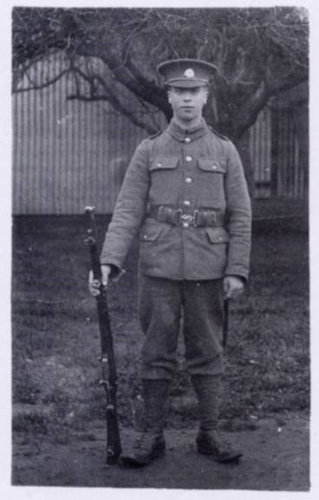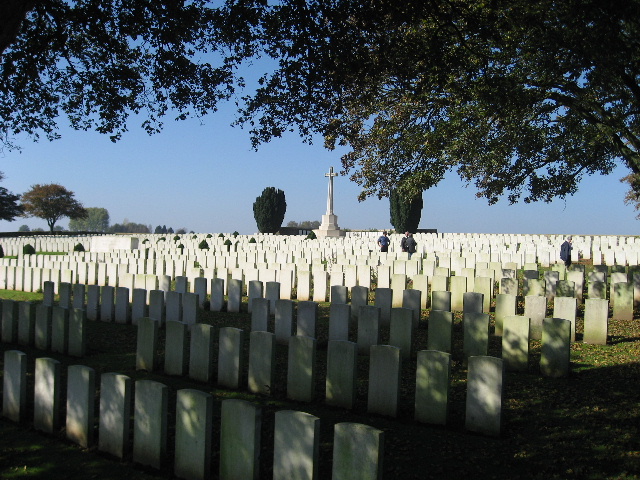Name
Frank Handscombe
Conflict
First World War
Date of Death / Age
11/07/1916
22
Rank, Service Number & Service Details
Private
22173
Bedfordshire Regiment
6th Bn.
Awards: Service Medals/Honour Awards
British War and Victory medals
Cemetery/Memorial: Name/Reference/Country
GORDON DUMP CEMETERY, OVILLERS-LA BOISSELLE
V. J. 5.
France
Headstone Inscription
Blessed Are The Dead That Die In The Lord
UK & Other Memorials
Pirton Village War Memorial,
St Mary’s Shrine, Pirton,
Methodist Chapel Plaque, Pirton,
Pirton School Memorial
Biography
Frank was the son of George and Martha Handscombe (née Dawson) and born in 1893. He seems to have had fifteen siblings or half-siblings. His father was married twice, the first time to Eliza Pearce. They were married in 1866 and had seven children(*1). These would all be half brothers and sisters to Frank. Eliza died in 1882 and George remarried a year later. His new wife was Martha Dawson and she had one son already, Harry Dawson.
Together George and Martha had nine children((*2) including seven boys and of those four served. Two, Charles and Hedley, both survived the war and two died; Frank who is the subject of this chapter and Joseph who is documented in a later chapter. All the family members listed were born in Pirton.
Frank and his parents lived in a thatched cottage set back from Shillington Road and which was near to the present number fifteen. We know from newspaper cuttings that Frank was secretary for the Wesleyan Chapel Sunday School and also taught the children there. The Chapel stood towards the bottom of the High Street in an area known as Burge End and next to where the Hammond’s Almshouses stand today.
The Parish Magazine of September 1915 confirms that he enlisted in 1915 before July 31st and was serving in the 2nd Battalion, Bedfordshire Regiment. However, when Frank was killed in action on July 11th 1916 he had moved to the 6th Battalion of the Bedfords and was just twenty-two years old.
The 6th Battalion was another service battalion formed for the duration of the war. After training they left for the Front, boarding trains at Ludgershall Station, which lies to the west of Andover and travelled to Southampton. Then they boarded the Empress Queen at 6:30pm and by 7:00am on July 31st 1915 they had landed at Le Havre, France. They marched to No. 5 Camp on the outskirts of Le Havre and later they gathered at St. Omer before moving to the Front. It is not certain if Frank was with them at that time, as that would depend on how early in 1915 he actually enlisted.
Frank’s Battalion served entirely on the Western Front. In the first twelve months, the period up to Frank’s death, they saw a significant amount of action. In 1915 they manned the trenches around Hannescamps and Bienvilliers. They had a mini heat wave in September followed by rain and then hard frosts. In late November when the thaw came they were knee-deep in water and mud. The cold and the rain continued into December. During this time artillery and snipers were active on both sides and, in the 6th, casualty numbers slowly mounted. They saw in the New Year while in the trenches before being relieved on New Year’s Day 1916.
The action of 1916 continued on the level that they had become used to, as did the conditions in which they fought, but the war diary seems to indicate that the rate of casualties was increasing. In February they saw Zeppelins and increased aircraft activity and the month ended with snow, a thaw and a lot of hard work to keep the trenches in reasonable condition. On March 20th they were given three days of complete rest as a reward for seven months in and around the trenches. This was followed by training and the formation of working parties of up to 500 men and, apart from a short time in the trenches, April was mostly work and training.
In May they moved to new trenches at Monchy-au-Bois where they were welcomed with a hostile bombardment, followed by an enemy raid at 3:00am. When things calmed down they counted 66 casualties and 8 men were missing, presumably taken as prisoners. After relief they formed working parties and then moved to Bailleumont for more work and a period of training. For most of June they moved between Bailleumont and the trenches at Bienvillers. On the 25th they had 5 men killed and 16 wounded.
The Battalion’s war diary helps establish the detail of Frank’s last days. Although they served in the Battle of the Somme, which has an infamous place in our history, they were not part of that horrendous first day, July 1st 1916, when there were 57,470 casualties including 19,240 men killed. They were in reserve, moving into the line east of Albert on the 8th. That day 4 men were killed and 14 wounded. The fighting quickly escalated and on the following day when 14 men were killed and 75 wounded with 1 missing. The 10th saw 6 more killed, 40 wounded and 4 men listed as missing. Then on the 11th, the date of Frank’s death, they moved to the support trenches and a working party was formed. It is not clear if Frank was in the working party or even if they are the ones that suffered the day’s casualties, but there were 9 confirmed casualties of whom 2 died; sadly Frank was one of them.
He is buried in Gordon Dump Cemetery. It lies about 1 ½ miles north-east of Albert in France. It is an exceptionally peaceful place, accessed by a long rough grass path and completely surrounded by farmer’s fields. Originally it was a small cemetery, but after the war, as was common practice, it was expanded as the men from scattered burial sites were brought together. It now holds the graves of 1,676 First World War servicemen, 623 are identified and 1,053 remain unidentified, although 34 of the named men are commemorated as buried in the cemetery amongst the unidentified graves.
The special inscription for Frank’s headstone, chosen by his family reads ‘Blessed Are The Dead That Die In The Lord’.
A memorial for Frank was held at the Wesleyan Chapel and conducted by the Rev. R E Parker. It was well attended and a solo, ‘Oh rest in the Lord’ was sung by Miss Bunyan. The collection was used for the Y.M.C.A. Huts’ Fund.
(*1) Miriam (b c1866), Caleb (bapt 1867), Emma (bapt 1868), Elijah (bapt 1869), Elizabeth (bapt 1871), Arthur G (b c1876) and Bertie (b c1879).
(*2) Frisby (b c1881), Charles (bapt 1884), Jane (b 1885), Fred (b 1888), Emma (b 1890), Sidney (b 1891), Frank (b 1893), Joseph (b 1896), and Hedley (b 1900).
Additional Information
Text from the book: The Pride of Pirton
Acknowledgments
The Pride of Pirton book – www.pirton.org.uk/prideofpirton Chris Ryan / Tony French / Jonty Wild



